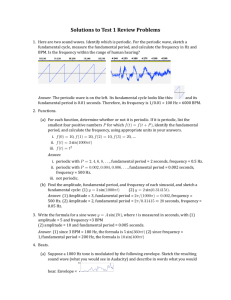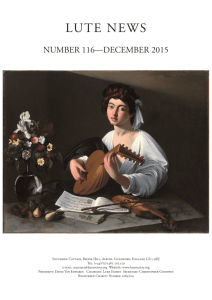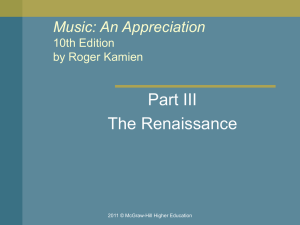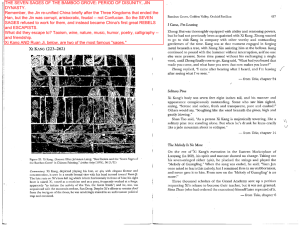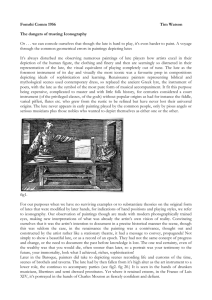Vol 3 - Whitwell - Essays on the Origins of Western Music
advertisement
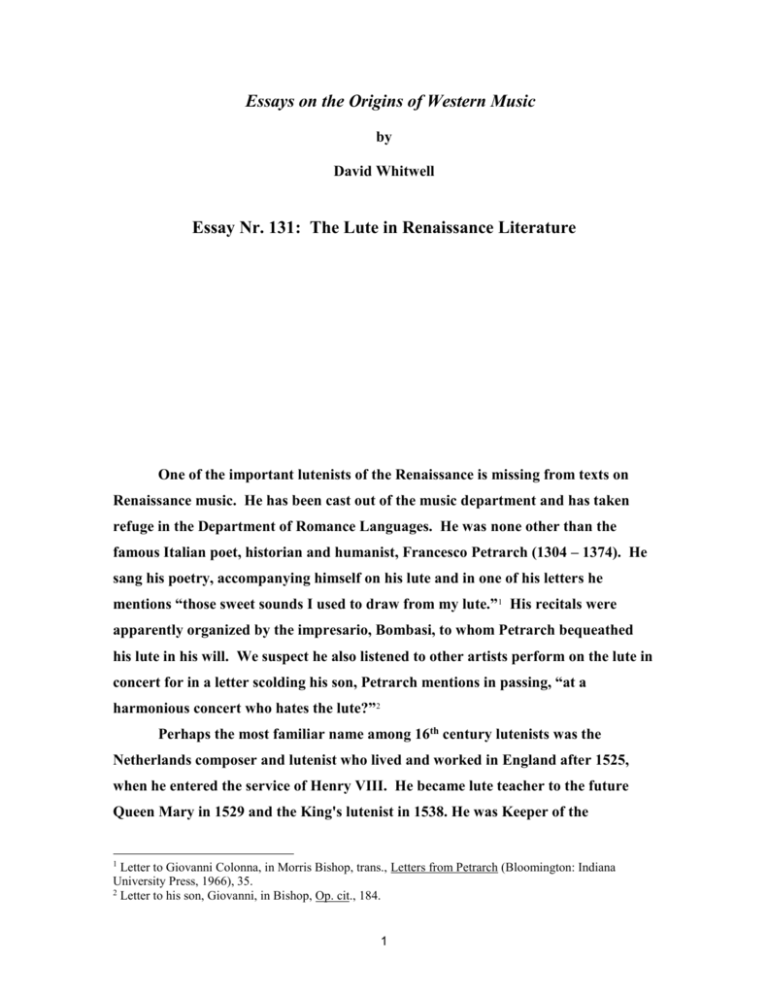
Essays on the Origins of Western Music by David Whitwell Essay Nr. 131: The Lute in Renaissance Literature One of the important lutenists of the Renaissance is missing from texts on Renaissance music. He has been cast out of the music department and has taken refuge in the Department of Romance Languages. He was none other than the famous Italian poet, historian and humanist, Francesco Petrarch (1304 – 1374). He sang his poetry, accompanying himself on his lute and in one of his letters he mentions “those sweet sounds I used to draw from my lute.”1 His recitals were apparently organized by the impresario, Bombasi, to whom Petrarch bequeathed his lute in his will. We suspect he also listened to other artists perform on the lute in concert for in a letter scolding his son, Petrarch mentions in passing, “at a harmonious concert who hates the lute?”2 Perhaps the most familiar name among 16th century lutenists was the Netherlands composer and lutenist who lived and worked in England after 1525, when he entered the service of Henry VIII. He became lute teacher to the future Queen Mary in 1529 and the King's lutenist in 1538. He was Keeper of the 1 Letter to Giovanni Colonna, in Morris Bishop, trans., Letters from Petrarch (Bloomington: Indiana University Press, 1966), 35. 2 Letter to his son, Giovanni, in Bishop, Op. cit., 184. 1 Instruments at Westminster when Henry died in 1547. Two of his sacred compositions are in the Gyffard partbooks and there are several manuscript works, including anonymous keyboard setting of his “Je file” is in “Lord Middleton's Lute Book” in Nottingham University Library. His name is best known through an anonymous poem composed upon his death, Bewaile with me all ye that have profest, Of musicke tharte by touche of coarde or winde: Lay down your lutes and let your gitterns rest, Phillips is dead whose like you can not find. Of musicke much exceadyng all the rest, Muses therefore of force now must you wrest. Your pleasant notes into an other sounde, The string is broke, the lute is dispossest, The hand is cold, the body in the ground. The lowring lute lamenteth now therefore, Phillips her friend that can her touch no more.3 The 15th century theorist, Tinctoris, mentions two fine players, Pietro Bono of Ferrara and Heinrich, a German in the service of Charles the Bold. The Germans, in particular, Tinctoris says “improvise marvelously upon a treble part with such taste that the performance cannot be rivaled.”4 A famous Spanish work of fiction by Fernando Rojas (1477 – 1541) refers to a singer and lutenist so fine even the birds stop to listen. His only relief is to take up his lute and sing. He sings the most mournful songs all about the departure of the soul and having courage in the face of death, just like those that great musician the Emperor Hadrian sang, I suppose, when he knew he was going to die. I don’t know much about music, but he seems to make that lute speak. When he sings, the very birds stop to listen with more pleasure than when they listened to the singer of old [Orpheus] who moved the trees and the stones, as they say, with his song.5 Anonymous, “Of the death of Phillips,” in Hyder Rollins, ed., Tottel’s Miscellany (1557-1587) (Cambridge: Harvard University Press, 1965), 162. 4 Anthony Baines, “Fifteenth-century Instruments in Tinctoris’s De Inventine et Usu Musicae,” in The Galpin Society Journal (1950), 24. 5 Fernando de Rojas, La Celestina, trans., J. M. Cohen (New York: New York University Press, 1966), Act IV. 3 2 Carpenter mentions a professor, Oronce Fine, professor of mathematics in the College de France who was also an outstanding performer on the lute.6 Less capable players are rarely mentioned in literature, but we notice a record of the Scuola de San Rocco for July 16, 1531, in which we find, ...to change the players of harp and lute that served us badly to those players who were at the School on Corpus Christi Day....7 The lute was, of course, a popular instrument during the Renaissance and Tinctoris mentions that it was heard “at feasts, dances and public and private entertainments.8 Galilei mentions that an advantage of the lute is that you can play it anyplace, “such as walking, riding horseback, sitting at the window, or in bed....”9 Ruiz, in his The Book of True Love, describes an Easter procession in a 14th century town, in which we see jongleurs and members of Religious Orders. Among the many instruments he describes is the, Big-bellied lute which marks the time for merry, rustic dance. 10 No doubt it was most used as an instrument to accompany singers, as was the case with Petrarch which we mentioned above. We read, that in 1342 when the war against Pisa was not going well for the Florentines, a locally famous popular singer, Antonio Pucci, took up his lute and began singing under the windows of the palazzo a song of the Virgin Mary, intended to urge the civic leaders to sue for peace.11 One measure of the instrument’s popularity is found in the fact that lute strings were a recognized commodity used in barter. This is mentioned in an Elizabethan play, Lodge and Greene’s A Looking Glasse for London and England. Here a common citizen has been cheated in a trial. He had been promised a payment of forty pounds and is objecting to the fact that he was paid ten pounds in 6 Nan Cooke Carpenter, Music in the Medieval and Renaissance Universities (Norman: University of Oklahoma Press, 1958), 140ff. 7 Denis Arnold, “Music at the Scuola de San Rocco,” in Music and Letters (July, 1959), XL, 232. 8 Anthony Baines, Op. cit., 24. 9 Vincenzo Galilei, Fronimo (1584), trans., Carol MacClintock (Neuhasen-Stuttgart: Hanssler-Verlag, 1985), 87. 10 Juan Ruiz, The Book of True Love, trans., Saralyn Daly (University Park: Pennsylvania State University Press, 1978), 1225ff. 11 Quoted in John Addington Symonds, Renaissance in Italy (New York: Capricorn Books, 1964), I ,222. 3 cash and thirty pounds in Lute strings.12 Another illustration of the popularity of the lute is found in the fact that for a long time a particular glossy fabric used in women’s dresses and ribbons was called “lutestring.” Perhaps another measure of the popularity of the lute was its use in fiction as a metaphor. In George Peele’s play, David and Bathsabe, it is used as a metaphor for a pleasing life. Adonia says, Amnon, thy life was pleasing to thy lord, As to mine ears the music of my lute, Or songs that David tuneth to his harp....13 In another play, Lyly’s Loves Metamorphosis, we find this interesting analogy equating the lute and a lady’s emotional state. Silvestris. My lute, though it has many strings, makes a sweet consent; and a Lady’s heart, though it harbor many fancies, should embrace but one love. Niobe. The strings of my heart are tuned in a contrary key to your Lute, and make as sweet an harmony in discords, as your’s in concord. Silvestris. Why, what strings are in Lady’s hearts? Not the base. Niobe. There is no base string in a woman’s heart. Silvestris. The mean? Niobe. There was never mean in woman’s heart. Silvestris. The treble? Niobe. Yea, the treble double and treble; and so are all my heartstrings.14 The Catholic poet, John Skelton, taking note of the turmoil following Luther’s challenge to the Church, made Luther’s voice a lute. Ye stringed so Luther’s lute That ye dance all in a suit The heretics’ ragged ray, That brings you out of the way Of Holy Church’s lay....15 12 Thomas Lodge and Robert Greene, A Looking Glasse for London and England, George Glugston, ed. (New York: Garland Publishing, 1980), 157. This is one of the earliest English plays in which lower class characters act and speak appropriate to their class. 13 George Peele, David and Bethsabe, vii. 14 John Lyly, Loves Metamorphosis, III, i. 15 John Skelton, “A Replication,” in The Complete Poems of John Skelton, ed. Philip Henderson (London: Dent, 1959), 420. Skelton (1460-1529) was a tutor to the young Henry VIII and was a figure in the court until his satires against Wolsey brought him into disfavor. 4 One of the questions poised from time to time by philosophers was, with respect to the experiential nature of music, can a bad man compose good music? Closely related to this is a striking question by Rojas, Can a musician play in tune, if he himself is “out of tune?” In this passage, the love sick Calisto decides to sing a song of love. Calisto: Sempronio! Sempronio: Sir? Calisto: Bring me my lute. Sempronio: Here it is, sir. Calisto (sings): Can any grief compare With what I bear? Sempronio: The lute’s out of tune. Calisto: How can a man tune it who is himself out of tune? What sense of harmony can he have who is himself full of discords? A man whose will refuses to obey his reason, who has barbs in his breast, in whom peace and war, love and hate, injury, guilt, and suspicions battle together? Here, take the lute and sing me the saddest song you know.16 It may seem quite curious to the modern reader that during the Renaissance discussions of various instruments sometimes compared the lute with the organ. Of course the Renaissance organ was sometimes a rather small instrument, but nevertheless we are surprised when the two are compared with respect to range. A 16th century music treatise by Girolamo Cardano (1501 - 1576) discusses the physical nature of instruments at length, including the materials used in their construction (“The best gut strings come from dogs”). His most interesting discussion on this topic provides several criteria for judging the excellence of musical instruments,17 and one of these reads, 8. They should be capable of producing very small and a great number of intervals. In this regard the lute is superior to the organ. Another comparison between the lute and the organ we find most striking. Galilei’s book on lute intabulation discusses the expression of the emotions and he wonders if the lute is not limited, because it cannot sustain pitches. The lutanist 16 Rojas, Op. cit., Act I. Quoted in Clement Miller, Hieronymus Cardanus, Writings on Music (American Institute of Musicology, 1973), 55. 17 5 answers that the instruments most capable of this is the organ, but he has found on the contrary that such virtuosi of the organ, such as Claudio di Correggio and Gioseffo Guami, not by failure of their art and knowledge but by the nature of the instrument, have not been able, cannot, and never will be able to express the harmonies for affetti like durezza, mollezza, asprezza, dolcezza -- consequently the cries, laments, shrieks, tears, and finally quietude and rage -- with so much grace and skill as excellent players do on the lute....18 Galilei also provides interesting discussion regarding various technical solutions in aesthetic terms. He says, for example, that to repeat a note without reason “would cause the refined ear no little annoyance.”19 In another place, a lutanist tells him that he chose to repeat a note in a tenor part of a canzone “for very good reason, because striking it again brought to delicate ears a je ne sais quoi of sadness.”20 Galilei that the lutanist might omit repeated notes “for more grace,” and “to furnish some novelty of the ear -- which, like all the other senses, is fed by it.”21 Similarly, that the use of rests, depending on their use, can result in “grace” or“dullness.”22 The art of intabulation, as presented by Galilei, consists frequently in the reduction of a polyphonic vocal work for an instrument. If the player does not, in effect, rewrite the work, leaving out notes which had to be repeated in the original only for the purpose of syllables, the result is a performance with “little grace [and] often intolerable insipidity.” Galilei makes it clear that the primary aesthetic goal in such transcriptions for instruments is still “the conceits of the words,” and not merely “the pleasure which the variety of sounds brings to the ear.”23 We should add here, that later Galilei makes an extraordinary statement relative to the reduction of larger works for a single lute, a statement which reflects a type of music nowhere mentioned in music history books. In raising the question whether it might 18 Vincenzo Galilei, Fronimo Op. cit., 87. Ibid., 54. 20 Ibid., 55. 21 Ibid., 171. 22 Ibid., 54. 23 Ibid., 56. 19 6 be well to add another string to the lute, the answer is, no, good players don’t need it. Then he says of Fronimo, his friend the lute player, I have often seen him many times intabulate and play music for 40, 50 and 60 parts [!], but never yet...has he been able to find anything, not the least thing, that might have been necessary to add to the ordinary lute to communicate it perfectly to the ear.24 Another aesthetic goal in transcription is that any addition of improvisation [passages and diminutions] must not obscure the original lines. In this regard the lutanist again expresses himself with purely aesthetic goals. Beauty, grace and the delight of the ear is the object, he says, not instilling moral virtues. Further, I have never committed [such] errors...nor have I spoiled or impeded the order of fugues so that they could not be heard entirely. Rather have I proceeded to help them (if I can use that word in such a connotation) by making the voices clear and by augmenting the parts and the whole with sonority, beauty and grace in the best possible way that I knew how and was able to do, in order to completely delight the sense of hearing -- which is indeed the proper aim of Music in our time -- without any regard to inducing in the souls of the hearers one virtuous habit rather than another, as formerly the ancient Greek writers had it....25 A very interesting, and important, observation on performance practice by Galilei is that one should not aspire to simply play what is on the page. And let it not come into your mind to try to defend yourself with the silly excuse of some who say they did not feel called upon to do more than that which they found written or printed....26 The two reasons he gives for his premise are quite valid, aesthetically. First, written and printed music often has errors, which of course one should not aspire to play, but more important the player’s goal toward the composer should be to communicate “not only what he says but often what he wished to say.” Above we have quoted the extraordinary passage by Galilei regarding the strong emotions communicated by Renaissance lute players. A poem by Thomas Wyatt reminds us it is the player who does this, not the instrument. 24 Ibid., 159. Ibid., 61ff. 26 Ibid., 83. 25 7 Blame not my lute, for he must sound Of this or that as liketh me: For lack of wit the lute is bound To give such tunes as pleaseth me. Then though my songs be somewhat strange And speaks such words as touch they change, Blame not my lute.27 A different kind of emotional display is found in the anonymous “The passionate Morrice” of 1593. Here, in of a rare example where music fails to soothe the listener, a lady throws her lute as she falls on her knees and cries. And after that, being indeed in her right mind,28 she took her lute, singing to her fingering this sonnet: What booteth love, that liking wants his joy? Grievous that joy which lacks his heart’s content.... Which music would be so metamorphosed, as, in truth, her singing would turn to sighing, and her playing to complaining, when, in a rage, she would throw her lute down, beginning to dilate on her love’s unkindness, that could be so cruel as to stay four and twenty hours from her. 29 And then here is that first of all modern women, Kate, in Shakespeare’s comedy, The Taming of the Shrew. She expects to have a lesson on the lute but discovers the teacher is only a disguised suitor. Kate hits him over the head with his lute and called him a “fiddler,” an intended derogatory reference to an instrument still associated with peasants. Baptista. How now, my friend! why dost thou look so pale? Hortensio. For fear, I promise you, if I look pale. Baptista. What, will my daughter prove a good musician? Hortensio. I think she’ll sooner prove a soldier. Iron may hold with her but never lutes. Baptista. Why, then thou canst not break her to the lute? Hortensio. Why, no; for she hath broke the lute to me. I did but tell her she mistook her frets And bowed her hand to reach her fingering; When, with a most impatient devilish spirit, 27 Sir Thomas Wyatt, Collected Poems, ed., Joost Daalder (London: Oxford University Press, 1975), CXV. This familiar phrase refers, unconsciously, to the fact that the “real us” is the “right mind,” or the right hemisphere of the brain. 29 Anonymous, “The passionate Morrice,” in F. Furnivall, ed., Miscellaneous, Series VI, Shakespeare’s England, Nr. 2 (Vaduz: Kraus Reprint, 1965), 78. 28 8 “Frets, call you these?” quoth she; “I’ll fume with them”; And, with that word, she stroke me on the head, And through the instrument my pate made way. And there I stood amazed for a while. As on a pillory, looking through the lute, While she did call me rascal, fiddler.30 30 The Taming of the Shrew, II, i, 145ff. 9

